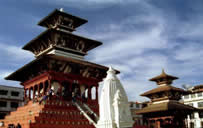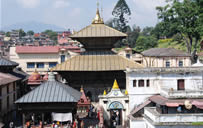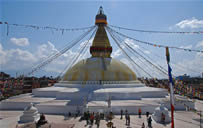


Kathmandu city tour
Kathmandu, the largest city of Nepal, is the political as well as cultural capital of the country. Kathmandu is a city where ancient traditions rub shoulders with the latest technological advances. However, it is the grandeur of the past that enchants the visitor whose gaze may linger on an exquisitely carved wooden window frame, an 18th century bronze sculpture or the spiritually uplifting stupas.
Retaining its ancient traditions, Kathmandu is blessed by a Living Goddess and is enriched by endless ceremonial processions and events that take to the streets every now and then with throngs of devotees seeking blessings. These religious festivals are steeped in legend and are quite a spectacle with chariot processions and masked dancers often possessed by the spirits of deities.
| Kathmandu Durbar Square |
| Situated in the heart of old Kathmandu city at Basantapur, Kathmandu Durbar Square never fails to impress first time visitors with its ensemble of palaces, courtyards and temples built during the Malla period. The Durbar Square includes the Hanuman Dhoka Royal Palace, the historic seat of the royalty; the magnificent Taleju Temple towering more than 40 meters; Kumari Ghar, the residence of the Living Goddess, Kumari; Ashok Vinayak, also called Kathmandu Ganesh, a temple without a filial ; and Kal Bhairav, the God of Wrath. The capital takes its name from the giant pagoda of Kasthamandap, which is said to have been built out of a single tree. Since the time of the Malla kings, the Durbar Square has been the city’s social, religious and political focal point. |
| Pashupatinath Temple |
| Situated 5 km east of Kathmandu, the temple of Lord Shiva is considered one of the most sacred Hindu shrines in the world. The two-tiered pagoda with golden roofs and silver doors houses the sacred linga, or phallic symbol, of Lord Shiva. Chronicles indicate the temple existed before 400 A.D. Near the Pashupatinath Temple on the banks of the Bagmati River lies Guheswari, where, according to mythology, a portion of Sati Devi, Lord Shiva’s consort, fell when a grief-stricken Shiva wandered aimlessly across the earth carrying her dead body on his shoulders following her self-immolation. |
| Bouddhanath Stupa |
| Situated 8 km to the east of downtown Kathmandu, Bauddhanath is one of the most imposing landmarks in Kathmandu, visible as soon as you land at the Tribhuvan International Airport. It is the largest stupa in the Kathmandu Valley and is the center of Tibetan Buddhism. |


